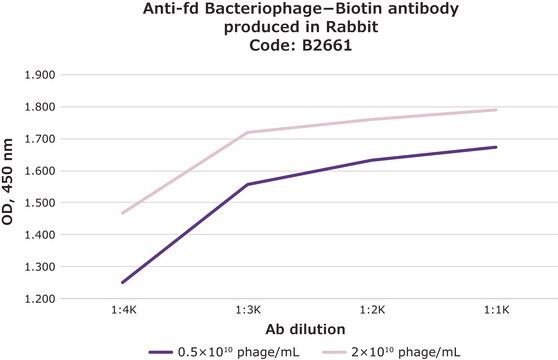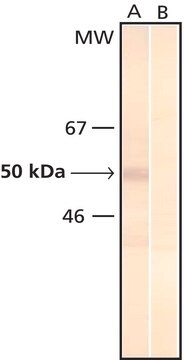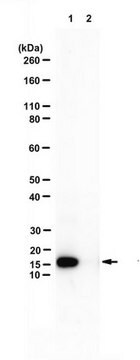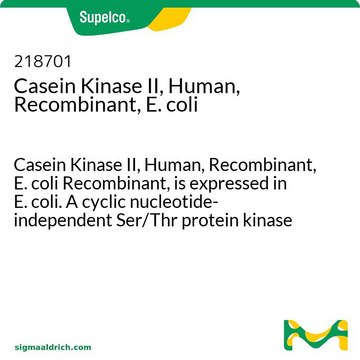B7786
Anti-fd Bacteriophage antibody produced in rabbit
IgG fraction of antiserum, buffered aqueous solution
Synonym(s):
Anti-fd Bacteriophage
Sign Into View Organizational & Contract Pricing
All Photos(1)
About This Item
UNSPSC Code:
12352203
NACRES:
NA.46
Recommended Products
biological source
rabbit
conjugate
unconjugated
antibody form
IgG fraction of antiserum
antibody product type
primary antibodies
clone
polyclonal
form
buffered aqueous solution
packaging
antibody small pack of 25 μL
technique(s)
indirect ELISA: 1:1,000 using 5 × 1010 phage/ml
shipped in
dry ice
storage temp.
−20°C
target post-translational modification
unmodified
Looking for similar products? Visit Product Comparison Guide
Related Categories
Specificity
The antibody binds specifically to phage coat proteins of fd phage or M13 phage and thus may act as a capture antibody when coated directly on multiwell plates or as a primary detection antibody for specifically captured fd or M13 phage. The antibody may be useful in rapidly sorting large phage display libraries (antibody, peptide, etc.) with the expressed proteins fused to either the gene III or to the gene VIII protein of the filamentous phage. The antibody may be used as a reagent in "phage ELISA" offering sensitive and specific activity for detection of recombinant phages.
Immunogen
fd bacteriophage
Application
Anti-fd Bacteriophage antibody produced in rabbit may be used in ELISA at a dilution of 1:1000. It was used to in antiphage immunohistochemistry.
B7786 Rabbit Anti-fd Bactieriophage may be used to sort phage display libraries (antibody, peptide, etc.) with expressed proteins fused to either the gene III or gene VIII protein of filamentous bacteriophage. The product may also be used in "phage ELISA" offering specific activity for detection of recombinant bacteriophage. It will also function as a capture antibody when coated directly on microwell plates or as primary detection antibody for specifically captured fd or M13 bacteriophage.
Physical form
Solution supplied in 0.01 M phosphate buffered saline, pH 7.4, containing 15 mM sodium azide
Preparation Note
Anti-fd Bacteriophage is developed in rabbit using repeated injections of fd bacteriophage as the immunogen. Whole antiserum is fractionated and then further purified by ion-exchange chromatography to provide the IgG fraction of antiserum which is essentially free of other rabbit serum proteins.
Disclaimer
Unless otherwise stated in our catalog or other company documentation accompanying the product(s), our products are intended for research use only and are not to be used for any other purpose, which includes but is not limited to, unauthorized commercial uses, in vitro diagnostic uses, ex vivo or in vivo therapeutic uses or any type of consumption or application to humans or animals.
Not finding the right product?
Try our Product Selector Tool.
Storage Class Code
12 - Non Combustible Liquids
WGK
nwg
Flash Point(F)
Not applicable
Flash Point(C)
Not applicable
Choose from one of the most recent versions:
Already Own This Product?
Find documentation for the products that you have recently purchased in the Document Library.
Mikhail G Kolonin et al.
FASEB journal : official publication of the Federation of American Societies for Experimental Biology, 20(7), 979-981 (2006-04-04)
In vivo phage display is a technology used to reveal organ-specific vascular ligand-receptor systems in animal models and, recently, in patients, and to validate them as potential therapy targets. Here, we devised an efficient approach to simultaneously screen phage display
Yasuto Akiyama et al.
Biomedical research (Tokyo, Japan), 35(2), 105-116 (2014-04-25)
Of all potential biological therapeutics, monoclonal antibody (mAb)-based therapies are becoming the dominant focus of clinical research. In particular, smaller recombinant antibody fragments such as single-chain variable fragments (scFv) have become the subject of intense focus. However, an efficient affinity
Mikhail G Kolonin et al.
Nature medicine, 10(6), 625-632 (2004-05-11)
Obesity is an increasingly prevalent human condition in developed societies. Despite major progress in the understanding of the molecular mechanisms leading to obesity, no safe and effective treatment has yet been found. Here, we report an antiobesity therapy based on
Paola A Bignone et al.
Methods in molecular biology (Clifton, N.J.), 1357, 269-283 (2014-11-21)
The ability of human pluripotent stem cells (hPS) to both self-renew and differentiate into virtually any cell type makes them a promising source of cells for cell-based regenerative therapies. However, stem cell identity, purity, and scalability remain formidable challenges that
Anne S Knudsen et al.
Scientific reports, 12(1), 3040-3040 (2022-02-25)
The pathogenesis of malaria is associated with blood-stage infection and there is strong evidence that antibodies specific to parasite blood-stage antigens can control parasitemia. This provides a strong rational for applying blood-stage antigen components in a multivalent vaccine, as the
Our team of scientists has experience in all areas of research including Life Science, Material Science, Chemical Synthesis, Chromatography, Analytical and many others.
Contact Technical Service








